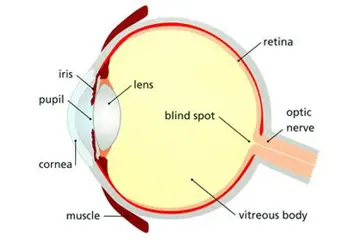
Iris
The iris is the coloured part of the eye. It surrounds the pupil and controls how much light enters it. Tiny muscles in the iris change its shape, making the size of the pupil larger or smaller too. The colour, texture and pattern of your iris are more unique than your fingerprints.
Pupil
The pupil is a hole at the centre of the iris. The amount of light which enters the eye depends on the size of the pupil, which is controlled by muscles in the iris.
Doctors often examine how the pupil reacts to light to check that the visual system is working correctly. As the light gets brighter the pupil should shrink, while reducing the light should make it grow larger.
Sclera
The sclera is the outermost layer that surrounds the eye. The front part of the sclera joins the cornea at the very front of the eye.
It is made of a tough, shiny white tissue and is there to protect the eye and help give it a firm, regular shape.
Cornea
The cornea is a dome shape covering the front of the eye. Although it is very transparent and only half a millimetre thick, the cornea helps protect the eye from external damage.
Together, the cornea and the lens bend light that comes into the eye, which is one stage of the process of giving us vision.
Lens
The lens is transparent and sits behind the iris. Its job, along with the cornea, is to focus light on the retina at the back of the eye.
The lens is suspended in the eye by fibres which are attached to the ciliary muscle. This muscle changes the shape of the lens so you can focus on objects at different distances.
Choroid
The choroid is the middle layer of the eye between the retina and the sclera. It also contains a pigment that absorbs excess light so preventing blurring of vision.
Ciliary body
The ciliary body is the part of the eye that connects the choroid to the iris.
Retina
The retina is a transparent structure situated behind your pupil at the back of the eye. It is enclosed in a thin transparent capsule and helps to refract incoming light and focus it onto the retina. It contains millions of cells that are sensitive to light.
Light passes through the eye and reaches the retina, which converts the light into electric signals which are then sent to the brain. The brain processes these signals to create an image, so that we can understand what we are seeing.
A cataract is when the lens becomes cloudy, and a cataract operation involves the replacement of the cloudy lens with an artificial plastic lens.
Macula
The macula is a small spot near the middle of the retina. It is the part of the eye that is responsible for the central, sharpest part of our vision.
Fovea
The fovea forms a small indentation at the centre of the macula and is the area with the greatest concentration of cone cells. When the eye is directed at an object, the part of the image that is focused on the fovea is the image most accurately registered by the brain.
Vitreous
The vitreous is a jelly-like material that fills the middle of the eye, between the lens and the retina. After light passes through the lens, it shines straight through the transparent vitreous to the back of the eye.
Vitreous helps give the eye its form and shape.
Optic disc
The optic disc the visible (when the eye is examined) portion of the optic nerve, also found on the retina. The optic disc identifies the start of the optic nerve where messages from cone and rod cells leave the eye via nerve fibres to the optic centre of the brain. This area is also known as the 'blind spot’.
Optic nerve
The optic nerve leaves the eye at the optic disc and is connected to the back of the eye near the macula, and carries signals from the retina to the brain.
Sclera
The sclera is the white part of the eye, a tough covering with which the cornea forms the external protective coat of the eye.
Rod cells
Rod cells are one of the two types of light-sensitive cells in the retina of the eye. There are about 125 million rods, which are necessary for seeing in dim light.
Cone cells
Cone cells are the second type of light sensitive cells in the retina of the eye. The human retina contains between six and seven million cones; they function best in bright light and are essential for acute vision (receiving a sharp accurate image). It is thought that there are three types of cones, each sensitive to the wavelength of a different primary colour – red, green or blue. Other colours are seen as combinations of these primary colours.
Conjunctiva
The conjunctiva is a thin membrane. It lines the inside of the eyelids and the surface of the eyeball.
The conjunctiva protects the eye and keeps the eye moist.
Aqueous
The aqueous humour is a clear fluid that fills the space between the cornea and the iris. It is produced by a part of the eye called the ciliary body which lies just behind the iris.
Aqueous is important in controlling the pressure inside the eye and giving the front of the eye its shape.